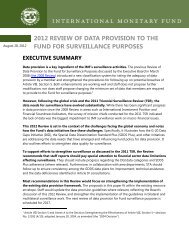ECB Annual Report on supervisory activities
ssmar2016.en.pdf?utm_source=POLITICO.EU&utm_campaign=b1bb431652-EMAIL_CAMPAIGN_2017_03_23&utm_medium=email&utm_term=0_10959edeb5-b1bb431652-189797857&utm_source=POLITICO
ssmar2016.en.pdf?utm_source=POLITICO.EU&utm_campaign=b1bb431652-EMAIL_CAMPAIGN_2017_03_23&utm_medium=email&utm_term=0_10959edeb5-b1bb431652-189797857&utm_source=POLITICO
You also want an ePaper? Increase the reach of your titles
YUMPU automatically turns print PDFs into web optimized ePapers that Google loves.
The Basel III reforms have not been<br />
finalised yet<br />
In January 2017 the GHoS welcomed the progress made by the BCBS towards<br />
completing the post-crisis regulatory reforms. It noted, however, that more time was<br />
needed to finalise the reform proposals before the GHoS could review them. The<br />
work is expected to be completed in the near future.<br />
More generally, <str<strong>on</strong>g>ECB</str<strong>on</strong>g> Banking Supervisi<strong>on</strong> participates in more than 30 groups, subgroups<br />
and task forces of the BCBS. In additi<strong>on</strong> to the revised market risk<br />
framework, the following reforms were agreed during the course of 2016: treatment<br />
of interest rate risk in the banking book, revisi<strong>on</strong>s to the securitisati<strong>on</strong> framework,<br />
and a standard for the regulatory capital treatment of banks’ investments in total<br />
loss-absorbing capacity (TLAC). The BCBS also issued public c<strong>on</strong>sultati<strong>on</strong>s <strong>on</strong> the<br />
regulatory treatment of accounting provisi<strong>on</strong>s and Pillar 3 disclosure requirements.<br />
C<strong>on</strong>tributi<strong>on</strong> to the work of the EBA<br />
At the EU level, <str<strong>on</strong>g>ECB</str<strong>on</strong>g> Banking Supervisi<strong>on</strong> c<strong>on</strong>tinued to work together with the EBA<br />
towards the shared objective of harm<strong>on</strong>ising prudential rules for financial instituti<strong>on</strong>s,<br />
which is key to ensuring c<strong>on</strong>sistent supervisi<strong>on</strong> across the European banking sector.<br />
In 2016 <str<strong>on</strong>g>ECB</str<strong>on</strong>g> Banking Supervisi<strong>on</strong> representatives participated in more than 35 EBA<br />
sub-structures (standing committees and sub-groups) and in the main committee,<br />
the EBA Board of Supervisors, in which <str<strong>on</strong>g>ECB</str<strong>on</strong>g> Banking Supervisi<strong>on</strong> participates as a<br />
n<strong>on</strong>-voting member.<br />
<str<strong>on</strong>g>ECB</str<strong>on</strong>g> Banking Supervisi<strong>on</strong> actively c<strong>on</strong>tributes to all the working groups in which it<br />
participates. On Pillar 2, for instance, <str<strong>on</strong>g>ECB</str<strong>on</strong>g> Banking Supervisi<strong>on</strong> worked in close<br />
cooperati<strong>on</strong> with the EBA in 2016 regarding the development and implementati<strong>on</strong> of<br />
acti<strong>on</strong>s aimed at deepening <strong>supervisory</strong> c<strong>on</strong>vergence in Supervisory Review<br />
and Evaluati<strong>on</strong> Processes (SREP) and Pillar 2 measures. In particular, it has<br />
actively participated in the development of guidelines <strong>on</strong> the SREP (EBA Guidelines<br />
2014/13), <strong>on</strong> interest rate risk in the banking book (EBA Guidelines 2015/08 <strong>on</strong><br />
IRRBB), <strong>on</strong> the EBA opini<strong>on</strong> <strong>on</strong> the interacti<strong>on</strong> of Pillar 1, Pillar 2 and combined<br />
buffer requirements and restricti<strong>on</strong>s <strong>on</strong> distributi<strong>on</strong>s published <strong>on</strong> 16 December<br />
2015, and in the development of a comm<strong>on</strong> EU approach to Pillar 2 capital guidance.<br />
In additi<strong>on</strong>, <str<strong>on</strong>g>ECB</str<strong>on</strong>g> Banking Supervisi<strong>on</strong> cooperated with the EBA in the preparati<strong>on</strong> of<br />
the EBA annual report <strong>on</strong> <strong>supervisory</strong> c<strong>on</strong>vergence.<br />
<str<strong>on</strong>g>ECB</str<strong>on</strong>g> Banking Supervisi<strong>on</strong> also worked closely with the EBA in developing the<br />
regulatory products defined as part of the Internal Ratings-Based Approach<br />
(IRB) 35 review. The <str<strong>on</strong>g>ECB</str<strong>on</strong>g> co-chairs the EBA Task Force <strong>on</strong> Model Validati<strong>on</strong>, whose<br />
objective is to assist the EBA in fulfilling its regulatory mandates related to credit risk,<br />
with a particular emphasis <strong>on</strong> IRB-related tasks.<br />
35<br />
The internal ratings-based approach (comm<strong>on</strong>ly referred to as “the IRBA”) is <strong>on</strong>e of the possible<br />
approaches that instituti<strong>on</strong>s can use to calculate capital requirements for credit risk. The framework<br />
includes two broad approaches that a bank can follow: the foundati<strong>on</strong> approach (FIRB), whereby banks<br />
calculate their own probability of default (PD) parameter, whereas the other risk parameters are<br />
provided in the CRR; and the advanced approach (AIRB), whereby banks calculate all their own risk<br />
parameters.<br />
<str<strong>on</strong>g>ECB</str<strong>on</strong>g> <str<strong>on</strong>g>Annual</str<strong>on</strong>g> <str<strong>on</strong>g>Report</str<strong>on</strong>g> <strong>on</strong> <strong>supervisory</strong> <strong>activities</strong> 2016 − The SSM as part of European and<br />
global <strong>supervisory</strong> architecture 48



